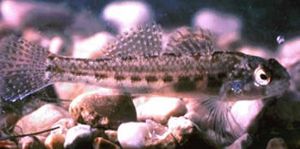Fountain darter facts for kids
Quick facts for kids Fountain darter |
|
|---|---|
 |
|
| Conservation status | |
| Scientific classification | |
| Synonyms | |
|
The fountain darter (Etheostoma fonticola) is a tiny, special fish. It's a type of darter fish, which belongs to the same family as perches. This small fish lives in only two rivers in Texas, United States: the Comal River and the San Marcos River. Fountain darters are usually less than 3 centimeters (about 1 inch) long. They eat very small water creatures. This fish is an endangered species, meaning it's at risk of disappearing forever.
Where They Live
The fountain darter is found in only two places. These are the very beginnings, or headwaters, of the Comal River and the San Marcos River in central Texas. These rivers are fed by natural springs. The darters need very specific conditions to live. They like open areas with a medium water flow. These spots are usually 3 to 5 feet deep near where the springs come out. The water flow must be slow enough for sand to settle on the bottom.
These springs are next to the main springs that bring a lot of cool, clear water into the rivers. Fountain darters need a steady water temperature, around 70 degrees Fahrenheit (21 degrees Celsius), all year round. The springs provide this perfect temperature. These two river spots are unique because they have many different kinds of plants and animals. There is more life here than in most other places nearby.
Life Cycle and Diet
The fountain darter eats small water creatures called invertebrates. These are tiny animals without backbones. Fountain darters can lay eggs all year long. They place their eggs on dead leaves, plant stems, rocks, or even algae. These small fish usually live for one to two years.
Protecting the Fountain Darter
Fountain darters mostly live on sandy areas or flat rocks. They avoid places with many rooted plants or decaying plant matter. They lay their eggs in the healthy, thick plants that grow in these unique, spring-fed rivers.
The fountain darter's home is very special. But it is also used by many people who visit the rivers. Sometimes, visitors accidentally harm these areas. This can happen if people are not careful or don't know how important these spots are. Also, new buildings and developments near the rivers can threaten the darter's home.
A tiny, worm-like creature called a trematode (Centrocestus formosanus) is another worry. This parasite is not native to the area. Scientists are still studying how it affects the darter population. As of 2004, only the Comal River darters were seriously affected by this parasite.
To help protect the fountain darter, there is a special reserve. The National Fish Hatchery and Technology Center in San Marcos, Texas keeps about 500 adult darters. This group acts as a backup in case something bad happens to the wild fish. The IUCN says this species is "Endangered".
Conservation efforts are underway to help these fish. People are encouraged to use less water. This helps keep the springs flowing strongly. It also helps to keep the rivers clean and free from trash.
See also
 In Spanish: Etheostoma fonticola para niños
In Spanish: Etheostoma fonticola para niños


